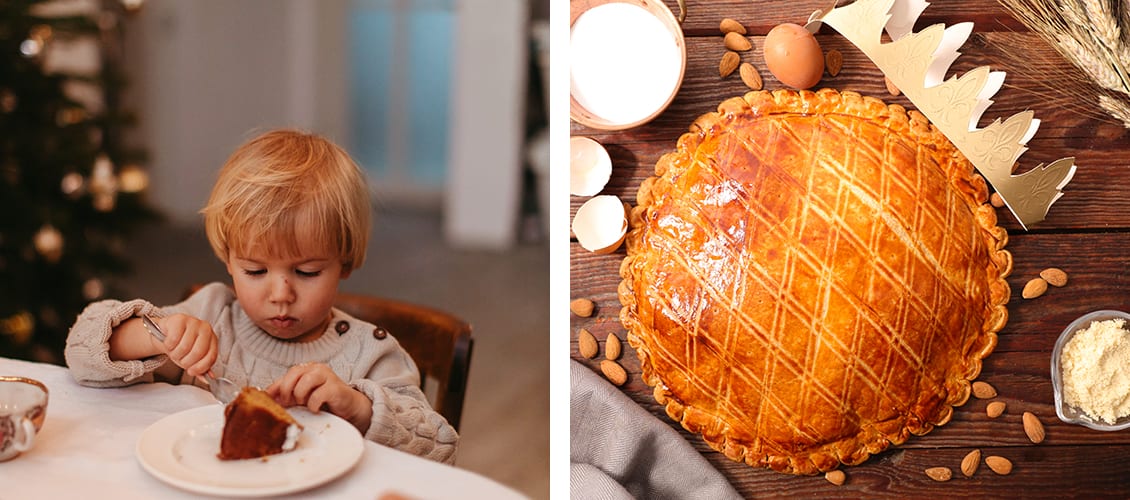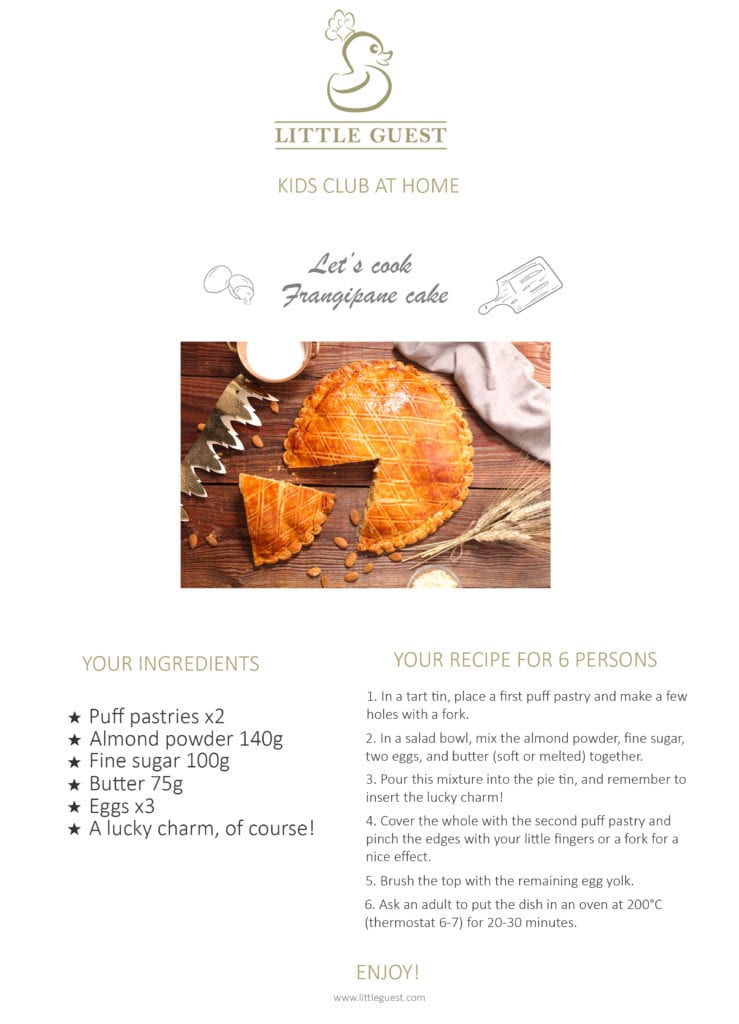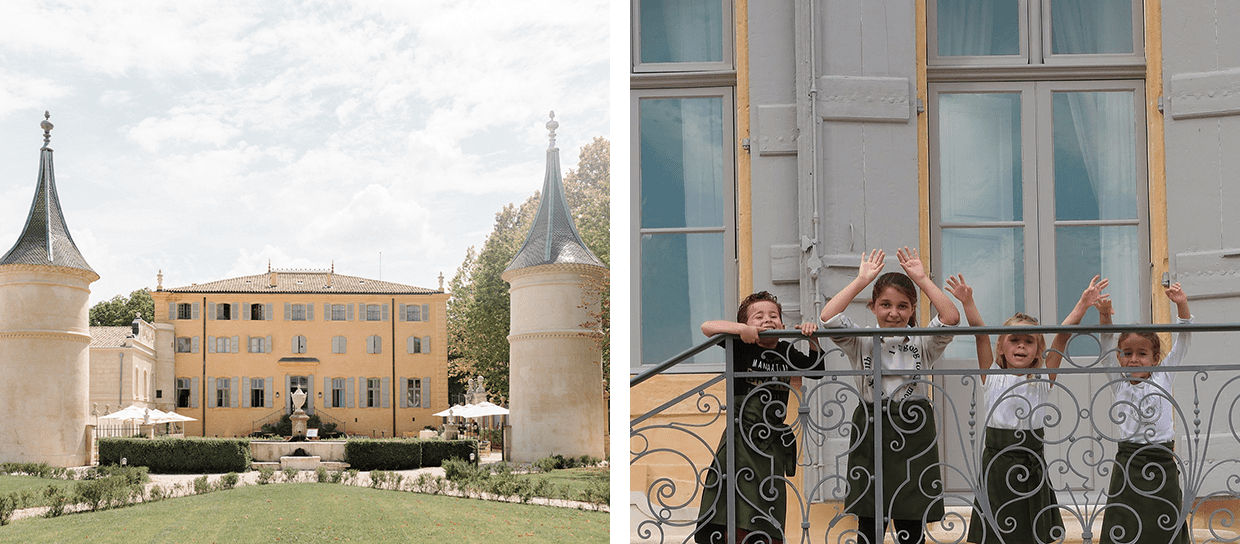Why do we eat the king’s cake?
Family celebrations are so sweet: receiving gifts, eating chocolates, spending time with loved ones, or becoming King or Queen for a day and falling back into childhood. Lucky will be the one who discovers the bean or the little figurine well hidden in the hollow of a smooth brioche… but why do we eat the twelfth night cake? Little Guest reveals the origins of this tradition, as well as a delicious frangipane recipe to make with your child.

I – Once upon a time, a king’s cake…
Saturnalia, according to the Romans
In order to thwart Saturn’s towers, the Romans had a tradition of celebrating Saturnalia between the end of December and the beginning of January. For seven days, the idea was to forget the diktats and hierarchical codes. On this occasion, the « King’s Cake » was presented to the feasters: The King of the Day (the one who fell on the bean) had the power to express all his desires. Thus, it happened that a slave would take the place of his master for a day.
The tradition of asking the youngest guest to sit under the table to blindly distribute the slices stems from this feast.
Epiphany, according to the Christians
Every year, the 6th of January turns out to be an important day because this day not only celebrates the first appearance of the famous Sherlock Holmes in 1887 or the birth of Joan of Arc in 1412, but also the Epiphany, which dates back to the first centuries.
The term « epiphany » comes from the Greek « epipháneia » meaning « apparition ». According to the Christian religion, the 6th of January marks the first appearance of Jesus in broad daylight, as it is on this date that this religious figure was baptised in the Jordan River and that the Magi (or Wise Men) visited him following a mysterious star (this is the reason why the Christmas tree is traditionally crowned with a star).
II – A traditional, but above all convivial celebration
At Little Guest, we like to share a King’s Cake and crown whoever falls on the little figurine hidden inside, just like that, for the pleasure of being together and enjoying a delicious frangipane! We are pleased to share with you our magical and family-friendly recipe.

III – Combining a hotel stay with a baking class
Children love to get their hands dirty, so why don’t you offer them a pastry class during your next holiday?
The Château de Fonscolombe ***** is now the Provençal HQ for the little ones too! The chef is happy to welcome the little ones for a cooking workshop. The kids let their talent shine through during a fun course combining discovery and pleasure through techniques adapted to the youngest. « I did it myself » they will say with pride at the end of the session.
While the children enjoy this pastry class, the adults are also taking advantage of every moment of serenity by the pool or during a massage at the spa. It must be said that the whole family is pampered at this hotel. This large property built on a 12-hectare wooded park near Aix-en-Provence is classified as a historical monument and is kid-friendly: catering adapted for toddlers, outdoor and indoor activities, playroom and baby-sitting. Everything is in place for a successful family holiday! It’s a castle life that is hard to leave.

Did you know?
Different countries have very different traditions!
-
In France. Even within the territory of France, the galettes take on different tastes and shapes. While the majority of French people savour a pastry made from puff pastry filled with frangipane or apples, the southerners prefer the « gâteau des rois » (King’s cake), a sourdough bread in the shape of a crown perfumed with orange blossom water.
- In Switzerland, as well as in Belgium, the tradition is similar to that of France! Our Swiss neighbours are fond of the brioche cake, while our Belgian friends prefer the famous frangipane.
- In Spain, on the other hand, it is a whole different celebration. As Christmas has never become a major event, it is on Epiphany Day that children receive gifts, which are distributed by the Magi (los Reyes Magos), and not by Santa Claus.
- In the south of the United States, and mainly in New Orleans, the Kings’ Cake is decorated with the colours of Carnival to commemorate Mardi Gras, a feast that comes later than Epiphany (47 days before Easter, to be exact).
-
In Greece, the King’s Cake is called Vasilopita (which can be translated as St Basil’s Day cake, which is celebrated on January 1st): it is eaten from the first day of the year. Finding the hidden figurine (or the traditional bean) would bring luck for the following year…
Wherever you are in the world, Little Guest wishes you and your family the best!

Pernell, 24 years old, travel lover, from Angers, France
Our best-sellers hotels
Book with us!
Best price guarantee
7/7 concierge service
Guaranteed places at the kids-club
Samsonite travel gifts
Welcome and VIP benefits at the hotel
(4,9)
Let's keep in touch
Exceptional advantages, exclusive news, personalised travel tips: subscribe to our newsletter and make sure not to miss anything.
You will also like





